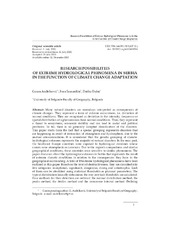Приказ основних података о документу
Research possibilities of extreme hydrological phenomena in Serbia in the function of climate change adaptation
| dc.creator | Anđelković, Goran | |
| dc.creator | Samardžić, Ivan | |
| dc.creator | Đukić, Duško | |
| dc.date.accessioned | 2021-09-24T15:45:24Z | |
| dc.date.available | 2021-09-24T15:45:24Z | |
| dc.date.issued | 2020 | |
| dc.identifier.issn | 1450-7552 | |
| dc.identifier.uri | https://gery.gef.bg.ac.rs/handle/123456789/1045 | |
| dc.description.abstract | Many natural disasters are nowadays interpreted as consequences of climate changes. They represent a form of extreme occurrences, i.e. deviation of normal conditions. They are recognized as deviation in the intensity, frequency or spatial distribution of a phenomenon from normal conditions. Thus, they represent a threat to ecosystems, economic stability and can lead to social and political problems. So far, there is no generally accepted classification of the disasters. This paper starts from the fact that a special grouping represents disasters that are happening as result of interaction of atmosphere and hydrosphere, due to the mutual interconnections. It is considered that the genetic grouping of climatehydrological extremes represents the majority of natural disasters. In the near past, the Southeast Europe countries were exposed to hydrological extremes whose causes were atmospheric occurrences. Due to the region's compactness and similar geographical conditions, these countries were sensitive to similar phenomena. The paper discusses about the hydrological extremes in Serbia that represents the result of extreme climatic conditions in relation to the consequences they have in the geographical surrounding. A total of 19 extreme hydrological phenomena have been outlined in this paper. Based on the level of destructiveness, they are classified into five categories: exceptional, significant, dangerous, strong and catastrophic. Each of them can be identified using statistical thresholds as physical parameters. The type of distribution basically determines the way in which thresholds are calculated. Four methods for their detection are outlined: the normal distribution method, the peaks method, the deciles method and the recurrence interval method. Defining each unfavorable phenomenon, their classification and determination of methods for detection are conditions for recognition and announcement. This allows an adequate reaction from the social community and the risks of disasters are reduced. | EN |
| dc.publisher | Beograd : Univerzitet u Beogradu - Geografski fakultet | |
| dc.rights | openAccess | |
| dc.rights.uri | https://creativecommons.org/licenses/by/4.0/ | |
| dc.source | Zbornik radova - Geografski fakultet Univerziteta u Beogradu | |
| dc.subject | extreme hydrological phenomena | en |
| dc.subject | Serbia | en |
| dc.subject | disasters | en |
| dc.subject | floods | en |
| dc.subject | thresholds | en |
| dc.title | Research possibilities of extreme hydrological phenomena in Serbia in the function of climate change adaptation | en |
| dc.type | article | |
| dc.rights.license | BY | |
| dcterms.abstract | Самарджић, Иван; Aнђелковић, Горан; Ђукић, Душко; | |
| dc.citation.issue | 68 | |
| dc.citation.spage | 5 | |
| dc.citation.epage | 21 | |
| dc.citation.other | (68): 5-21 | |
| dc.citation.rank | M52 | |
| dc.identifier.doi | 10.5937/zrgfub2068005A | |
| dc.identifier.fulltext | https://gery.gef.bg.ac.rs/bitstream/id/41/1043.pdf | |
| dc.identifier.rcub | https://hdl.handle.net/21.15107/rcub_gery_1045 | |
| dc.type.version | publishedVersion |


